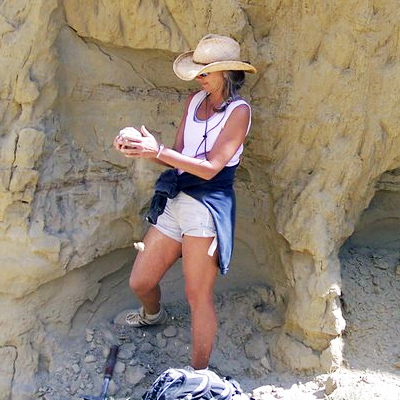Dinosaurs: how the future may, in some ways, lie in the past
Over 99% of all the organisms that have ever lived on our planet are now extinct; the fossil record is the only evidence of their existence. They occupied our same planet, with similar requirements to move and reproduce, respond to gravity, and acquire nutrients, but they were very different from today’s familiar life forms. Fossils of these organisms represent evolutionary experiments that have already been conducted. Extinct organisms, including dinosaurs, went through periods of global warming, global cooling, continental shifts, and changes in atmospheric CO2 far greater than anything the human species has ever seen. How did they survive? How did they change? These questions can only be answered by at looking the fossil record, because that is the only place the data can be found. Dr. Mary Schweitzer, of North Carolina State University, studies how dinosaurs were preserved in the first place, what exactly is preserved, and how the interpretation of small molecules preserved in the bones of these great animals can inform us about how they lived and functioned in their world.
Dr. Schweitzer and her team have challenged ‘conventional wisdom.’ It was widely assumed that original organics would not persist across geological time, but Dr. Schweitzer has found flexible transparent blood vessels and bone cells that still have molecular features in common with the same tissues in modern counterparts. This calls into question our assumptions about the durability of organic materials, and suggests that maybe, the limitations are not necessarily in the molecules themselves, but in our existing technology to recover, identify, and interpret them. While working to uncover the secrets of the dinosaurs’ past, Dr. Schweitzer hopes the results can inform on aspects affecting humans, and their future. Not only is she advancing science but also helping to propel a future generation of researchers by inspiring their curiosity and advancing them toward careers in the sciences. As one of the only labs in the world to focus on recovering proteins and other biological signals from materials retained in a sedimentary environment from the distant past of the Mesozoic, the tools and methods Dr. Schweitzer develops have broad applications extending beyond paleontology and evolutionary biology.
Current research includes:
- Preservation: Dr. Schweitzer studies why things don’t decay over time when scientists have claimed that all organic remnants should be lost. She has shown that iron plays a role in such preservation, and, because iron also plays a role in many human diseases, she and her team hope that what they are learning can be applied to broader questions. Investigating what happens when a dinosaur is buried and preserved might have unanticipated benefits.
- Molecules: Understanding how and why molecules preserve, as well as how they are modified after death, will greatly expand our understanding of molecules in general, and what kinds of modifications contribute to their longevity. This, in turn, will optimize search algorithms used in evolutionary studies, and will allow a more robust interpretation of molecular clocks -- how molecules evolve, over what timescales and at what regions of molecules.
- Environmental Remediation: The environment of dinosaurs contained elevated levels of CO2. Because many of the fossils from the Mesozoic that exhibit exceptional preservation are also found in association with microbial fossils, Dr. Schweitzer is studying whether microbial influence on very rapid mineral precipitation might be harnessed to help decrease the rising levels of CO2 in today’s world.
- Evolutionary Relationships: an organism’s evolutionary history is recorded in the molecules it produces, particular DNA and proteins. Understanding molecular relationships can inform on things as disparate as bioterrorism and the search for life on other planets (exobiology).
- Methods development: characterizing molecules in fossils requires development of new extraction methodologies, mass spectrometric methods and database search algorithms.
- Education: Dr. Schweitzer uses the excitement and curiosity about dinosaurs and the world of the past to inspire future scientists to enter STEM disciplines. Because paleontology requires knowledge and application of math, physics, chemistry, biology, histology, genetics and evolutionary biology concepts, as well as other disciplines, Dr. Schweitzer sees dinosaurs, and paleontology in general, as a very effective 'gateway drug' to the sciences.
Bio
Dr. Mary Schweitzer had not intended to pursue a career in academics. As a wife and a mother of three children, she found herself living in the same town as Jack Horner, the famous dinosaur hunter. Due to her longstanding interest in dinosaurs, when Jack Horner offered a class in comparative vertebrate paleontology, she went. Despite the class being one of the hardest she had ever taken, it was also very eye-opening. After the class, Dr. Schweitzer volunteered at the museum as a dinosaur preparatory to learn more, and by then, she was hooked. With three small children, however, she couldn’t go out into the field, and so needed a lab project. An ‘accidental’ discovery led to her thesis research, and eventually her current research.
In her free time, aside from research, Dr. Schweitzer enjoys downhill skiing, snowshoeing, horseback riding, camping, fly-fishing, hiking and scuba diving.
In the News
CBS News


